Key Club
1327-29 Washington Ave. So.
Minneapolis
At this notorious location you could hear the sublime, if you could get there alive!
HENRY SABES
South of the Border and the Key Club were owned by Henry Leonard Sabeswitz, who was born in 1909 in Minneapolis. He had his name changed to Sabes by court order before he was 31 years old. His parents were both born in Russia, and he was one of at least nine children. The family immigrated to America in 1900, and in 1920 his father was a fruit peddler.
In 1933, Henry was a clerk at the JB Hanson Grocery Store at 608 Filmore Street NE. It appears this building was torn down in 1934. He was robbed in August of that year.
In 1942, he was a partner in the American Sales Co., with Charles Berman. The company operated pinball machines and jukeboxes and placed them around town. In 1952 there was an investigation into the operation and in August he surrendered to Federal officials as a material witness.
He was also a stockholder and one of the organizers of Mercury Records.
“Hank” and his wife were active members of the Jewish community in Minneapolis, philanthropists, and he was an avid golfer. He died on November 21, 1994.
SOUTH OF THE BORDER: 1327 WASHINGTON AVE. SO.
The South of the Border Bar had been a Cafe before Sabes opened it in about August of 1939.
This venue appears to have been merely a bar. In 1963, Sabes testified that he had owned his property for 25 years. That would compute to 1938.
KEY CLUB: 1329 WASHINGTON AVE. SO
The Key Club was next to South of the Border. This had been the Bon Ton Cafe, going back to at least December 1926. There were two earlier references to the Bon Ton Cafe, but there was no address, so it’s unclear whether it’s the same place. The 1916 Bon Ton was described as “a greasy looking place about as big as a dog house.” (Minneapolis Tribune, May 13, 1916)
For a few years it was Joe’s Tavern, run by Joel Carlson until he got caught selling beer to minors. For this he lost his license and got sent to the Workhouse for 30 days. Joe’s tenure was from about May 1937 to January 1944. (Minneapolis Star, January 13, 1944)
Next was the Silver Star beer parlor, owned by Marie Janen. Oh, the stabbings! One terrible one was on July 4, 1946, and then there was another one – two women fighting about one husband – involving a hand axe and a pocket knife. Both of them were given 30 days in the Workhouse.
1951
There was no reason given, but in August 1951, owner Janen was ordered to move. She wanted to move to 1323 Washington Ave. So., but it was deemed to be too close to the Children’s Gospel Mission, at 1407 Washington Ave. So. The City was attempting to crack down on its ordinances about distances between bars and churches.
Just how the Key Club was allowed to move into the space is not clear, but it opened on December 19, 1951. The club featured top notch entertainment, especially jazz and rhythm & blues.
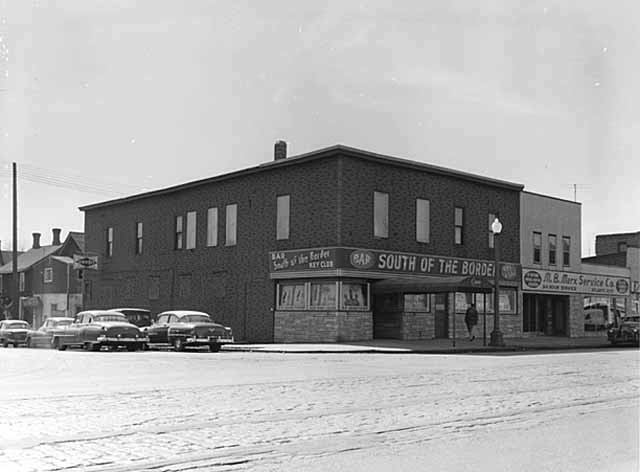
ENTERTAINERS AT THE KEY CLUB
NOTES:
Only known dates are given. Appearances may have started or ended before or after the dates provided unless definitely stated.
My comments seem redundant to the text on the ads, but the ads are not searchable, so I repeat them for those searching for particular artists.
Many of the uncited performers come from notes out of the Minneapolis Spokesman, the weekly newspaper serving the black community since 1934, published by Cecil E. Newman. Now that that publication is online, I hope to go back and search that database for more ads.
There will be many references to Will Jones – he was the entertainment columnist for the Minneapolis Tribune, and a treasure trove of information.
The first group to appear at the Key Club were the Four Blazes. They were in-house as of opening night until the end of January 1952, per Will Jones.
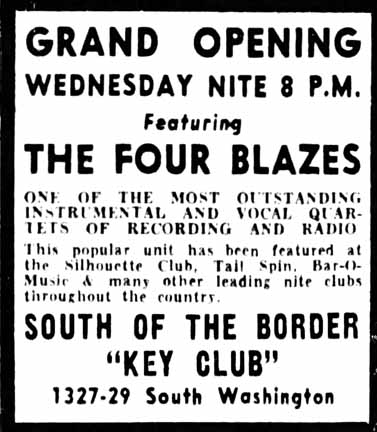
1952
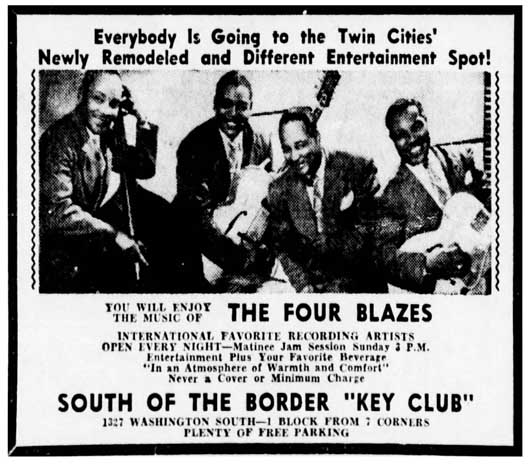
The Key Club promised “They Key to Pleasure in Fullest Measure.”
On January 18, 1952, Will Jones noted that every Sunday from 3 to 7 pm there was a jam session that left him with a “limp set of ears.” Chet Christopher’s bop group was the base, but as many as 20 musicians might sit in.
Jones said that customers sign cards and are issued keys. The keys don’t unlock anything, said Manager Frank Sloan. “Some joker might lock everybody in.” Later Sloan clarified that customers didn’t need the cards or keys to get in – they “give people an idea of being special.”
Irv Williams’ Quartet had moved into the Key Club by February 22, 1952, and became a sextet on Sunday jam sessions.
On March 5, 1952, 12 people were arrested after raids by Federal narcotics agents and the Minneapolis police morals squad. One of those arrested was an independent photographer working at the Key Club, who was arrested after narcotics agents bought marijuana cigarettes from him. (Minneapolis Star, March 5, 1952)
Cozy Eggleston’s Combo
The Delta Boys, “America’s Finest Sepia Combo”
Hank Hazlett
Little Donna Hightower, Decca’s famous recording artist
Stomp Gordon Combo, “King of Bop and Boogie – the Character who stomped his way to fame with his All Star Combo”
1953
“Always something new at the Key Club, where we make things happen”
The Five Young Moderns Jazz Group appeared from April 3 to May 8, 1953. The group featured Lou Levy, formerly of the Woody Herman Band. “Hottest Jazz band in the country.”

In August 1953, the performers were the Hank Hazlett Trio and four vocalists featuring Little Donna Hightower – “Man Alive it’s Jump & Jive Music With Drive” On August 11, Will Jones called Little Donna a Bop Singer, and said that she liked it in Minneapolis so much that she bought a house here and was booked indefinitely.
Scat Johnson Trio
Great Jimmy Binkley, Blue Note recording band
Bill Boone, the Man with the Horn
1954
Five Cats and a Kitten
“Peewee” Glover, sensational sax player
Earl Jackson and His Trio, D.P. Black, promoter
Four Gentlemen of Jest, D.P. Black, promoter
Oscar Frazier and the Four Notes
Erice Giere, Stanley Williams on drums, Ira Pettiford
Hank Hazlett
Wild Bill Boone
1955
1955 started out with Wild Bill Boone, and extremely popular local entertainer.
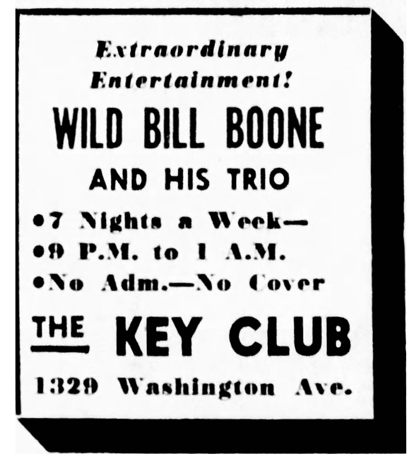
Boyd Moore Combo featuring Eva Gee, blues and torch singer, fresh from extensive eastern tour
“Nature Boy” Brown sax and his Harlem Playboys, direct from Chicago
1956
The Key Club really came into its own in 1956, just as other venues seemed to be slowing down – at least according to ads in the Minneapolis Spokesman.
Hank Hazlett Trio, January 30, 1956
THE STAFFORD KIDNAPPING
On February 15, 1956, singer Helen Stafford was kidnapped from her apartment above the Key Club. She and her husband had been playing cards when three men broke in. She jumped out of her second-story window, suffering rib and shoulder injuries. The men forced her into their car and “forced her to submit to indecencies,” she told police. They released her at Sixth Street and 19th Ave., where she went to the nearest house for help in the two below zero weather. Meanwhile, her husband had seen the men take off in a two-tone green car, which he reported to the police. In the apartment, the police found a pencil with the name of a St. Paul night club on it. St. Paul police were alerted, and the car was picked up at Larpenteur and Hamline after a high speed chase. The driver was tagged for speeding before they were turned over to Minneapolis. All three men were charged with sodomy; one was acquitted, one plead guilty, and the other plead innocent. (Minneapolis Star, February 15 and March 24, 1956)
Eddie “Cleanhead” Vinson, orchestra leader and saxophone player, began an indefinite engagement at the Club starting March 19, 1956. “This fabulous orchestra will set a policy of ‘better’ entertainment at the Key Club. Music as you like it plus exotic dancing.” With the new policy came a 50 cent admission fee on the weekends. (Minneapolis Spokesman, March 23, 1956)
Jimmy Witherspoon, blues singer; Betty DeQuincy, dancing entertainer fresh from Detroit; Stomp Gordon and His Combo, starting April 16, 1956.
Duke Groaner and His Combo plus Audrie DeYoung, exotic dancer, May 14, 1956
Bob Wilson and His Combo plus Black Velvet, interpretive and exotic dancer
Tiny Davis and Her Hell Divers took the stage from June 25 to July 2, 1956. The ads called them “The Rock and Roll Queens,” but they also played calypso, bop, and “funny-hat music,” according to Will Jones. She charged through the club blowing a five-foot long trumpet made in Germany, and a nine-inch-long trumpet made in Italy. She was fond of sitting in customers’ laps. The group once had 18 members but was now down to five. (July 2, 1956)
Camille Howard, song stylist and pianist; Larry Rice and Combo; comedian Mickey Martin, emcee, July 23, 1956
Billy Brooks and Piney Brown, song stylists; Jimmy Binley Combo, August, 1956
Larry Wrice and His Chicago All Stars; Florence Devereaux, song stylist; Tequila, exotic dancer, October 5, 1956
Miss Wiggles was an exotic dancer on the bill at the Key Club as of October 29, 1956 and into in November. She was billed as “The Upside Down Girl.” Will Jones wrote that “She does everything other exotic dancers do, only she does it upside down, while standing on her head. It’s weird.”
Rudy Hunter and the Fabulous Tones (from Hollywood), November 29, 1956
Dozier Boys, Fresh from Chicago, December 15, 1956
Dozier Boys and Chubby Newsom, vocalist from Detroit, December 21, 1956
On New Year’s Eve, 1956, Will Jones wrote that the Club was raising its cover charge from 50 cents to $1 for the evening. The entertainment was Rock ‘n’ Roll music and a stripper named Black Velvet. They were taking reservations “for people we know.”
1957
Jimmy Rogers was a “Marathon Drummer” who could play for 80 hours straight, supposedly. He began an extended appearance at the Key Club on January 17, 1957, along with a combo of organ, guitar and sax. Rogers had appeared on the “Today” show, and had been featured in numerous magazines, wrote Cedric Adams in the Star (January 22, 1957). Different singers and exotic dancers appearing with him through February.
On February 8, 1957, Beulah Bryant, “400 Pounds of Dynamite,” took the stage. She was described as a blues singer, and although she does not appear on the imdb.com list of cast members of “Gone With the Wind,” her singing may have been heard in the movie. Also on the bill was exotic dancer Lola DuConge and the Jimmy Rogers Quartette.
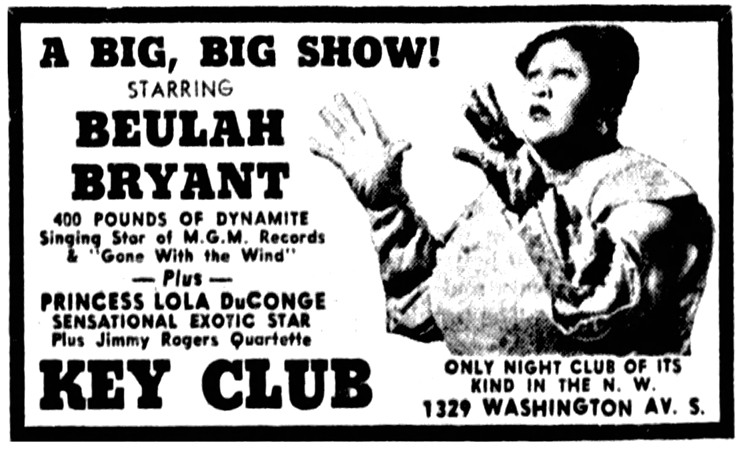
THE TALLEY SHOOTING
On February 24, 1957, at about 1:15 am, Sabes shot and killed Charles Maurice Talley, a 30-year-old singer and musician at the South of the Border. Talley, who had been drinking, got into an argument with Robert H. Johnson, 26, who accused Talley of paying too much attention to his wife, Allene. (The Johnsons were apparently from New Jersey and were at the bar with Allene’s mother.) Johnson pushed Talley, who retaliated by firing three shots at Johnson with his German automatic pistol. One shot hit Johnson in the ankle. Sabes rushed in and Talley fired two shots at Sabes. Sabes ran into a telephone booth and fired three shots at Talley with his snub-nosed .38 revolver. Talley was dead when police arrived. The Grand Jury determined that the shooting was self-defense. Talley was wanted on two warrants for abandonment and non-support.
On February 23, 1957, Emily Foster was the featured vocalist with Jimmy Rogers’ Combo. Cedric Adams found her to be “a bombshell of talent and showmanship and had the capacity crowd hoarse from shouting for more.” He wrote that some have called her “the female Sammy Davis, Jr.” (Star, February 26, 1957
HORACE HENDERSON
Decca recording artist and pianist Horace Henderson (brother of Fletcher Henderson) and His Rock ‘n’ Roll Combo began an extended appearance at the Key Club in March 1957. Henderson was a pianist-arranger for Lena Horne for two years, arranger for Charlie Barnet for three years, and also worked for the Benny Goodman and Jimmy Dorsey Bands. (Will Jones, August 29, 1957) His first show was advertised as a “Big Floor Show.. With Plenty of Sock.” Henderson would appear at the Key Club off and on until 1960.
Don Morrison wrote in his column that the Club passed out miniature drum sticks to the customers for drumming along with the music. (Tribune, April 29, 1957)
Other entertainers appearing at this time included comedy team Butterbeans and Susie (a/k/a Jodie and Susie Edwards).
From June to August 1957 the headliner at the Key Club was Rose Mary Gaiters, a singer “Second only to Ruth Brown,” with the Duke Groner Combo and a rotation of exotic dancers (one billed as a “variety girl.”)
National act Jay McShann, “The Band that Jumps the Blues,” appeared at the Key Club in August 1957 with the Rhythm Kings Trio (singers-dancers-comics-acrobats). Will Jones described Princess Lola De Conge, popular exotic dancer, as “another of the new crop of upside-down dancers who stands on her head on a chair to produce her most interesting wiggles.”
Jones also reported that the Club had another new roomful of tables from which the show may be seen. (August 9, 1957)
On August 29, 1957, Will Jones wrote that the Club was resuming its vaudeville policy with Horace Henderson’s house band and five acts.
In August 1957 Jimmy Binkley and his Popular Combo, the Dutch and Dutchy comedy team, and Lottie the Body were the featured performers at the Key Club.
Roy Milton and His Solid Senders appeared at the Key Club in September 1957 with Johnny “Guitar Jr.” Rogers and Tequila, Tempest of Dance. Will Jones was sorry to see Lottie the Body being replaced, if only for her name. The featured singer was a woman named Mickey Champion, who wore a fringed dress to emphasize her “shakes,” as Jones called them. (September 27)
ROY ELDRIDGE
The photo below is the only one I’ve seen of the inside of the Key Club. It was identified by the Minnesota Historical Society as Ira Pettiford and Roy Eldridge, but no date or year. So far I could not find a personal appearance by Roy Eldridge, but he was in town every fall with the Jazz at the Philharmonic troupe, from 1952 to 1957. The Key Club would have been a natural place to relax after the show. Best as I can figure out, and please correct me if I’m wrong, the photo shows Pettiford on the left, a member of Eldridge’s band in the middle, and Eldridge on the right.
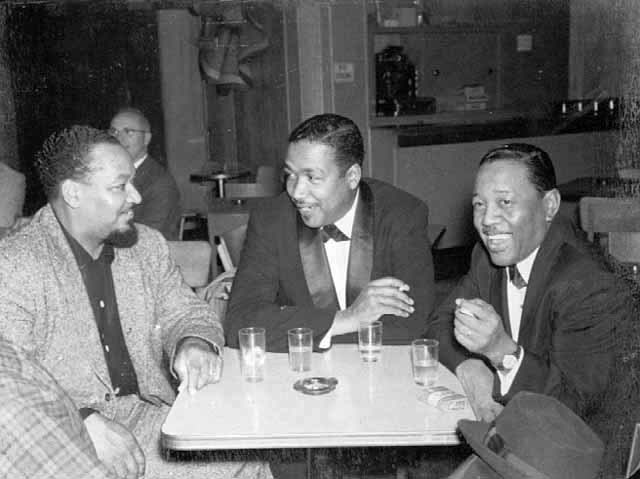
Bullmoose Jackson and His Buffalo Bearcats performed at the Key Club in November 1957. Also on the bill was “the very popular singer and dancing star Vi Kemp – A Daring Performer.. a touch of genius.”
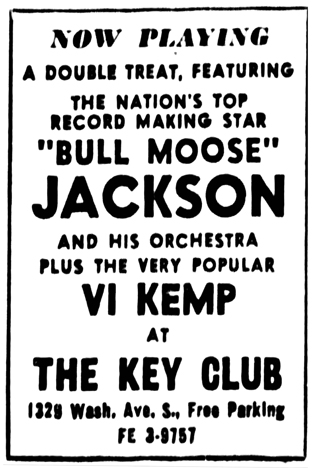
Mercury Recording Star Sil Austin opened at the Key Club on December 2 , 1957. Austin was a saxophonist, known for his instrumental, “Slow Walk.” Also on the bill were Olivette Miller, the World’s Greatest Swing Harpist, and Bert Gibson, Sensational Tap Dancer.
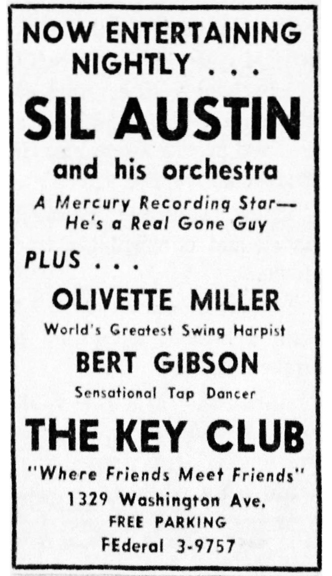
The Key Club’s 1957 New Year’s Eve show featured the Rhythm Kings (dance, song, comedy), Ira Pettiford and His Orchestra, Wild Bill Boone, Mel Carter, and exotic dancer Lady Ducongue.
1958
On January 9, Will Jones ticked off the acts he had seen the night before: Singer Helen Stafford, backed by Ira Pettiford, Wild Bill Boone, et. al. This was followed by Lola DeConge, who was always billed as an exotic dancer, but was described by Jones as a stripper.
20-year-old dancer “Peg Leg” Morfett was at the Key Club in February 1958 and was spotted by a talent scout and sent to New York. Will Jones wrote that “The lad does turn out an amazing performance considering that one of his dancing legs is a piece of hickory.” (February 12, 1958) This insensitivity might be excused when the parents of a seven-year-old boy read the story. Their son also had an artificial leg and had periodically become depressed. They wrote to Sabes, and he invited them down to see Peg Leg dance. Then the plan was for the two of them to have some private time to talk. “And I’ll wager that the dancer will put on perhaps the best performance of his entire career.” (February 21, 1958)
The Four Zeniths
The Singing Falcons
Tiny Topsy
Los Latinos
Chi Chi Valdez the Cuban Bombshell
Myra Taylor
Laura the Body Beautiful
Brother John Sellers opened on July 22, 1958 and held forth until August 3. Will Jones described him as a big-voiced singer of folk, church, and blues songs, and he was sorry to hear that he was leaving. At the Club he concentrated on blues numbers. He was reportedly going to New Orleans to appear in the movie “Great Gettin’ Up Morning,” with Mahalia Jackson.
NATIONAL ACTS
In August 1958, however, the Club started bringing in some serious national acts:
The Ink Spots performed at the Key Club for two weeks starting on August 4 to 17, 1958. Also on the bill were Pete and Repeat, and exotic dancer Lola De Conge. Horace Henderson headed the house band.
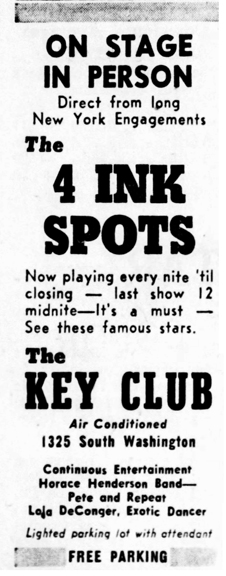
Ruth Brown, the “Queen of R&B,” appeared on August 18 and 19, 1958. She shared the stage with such acts as Pete and Repeat, and Exotic Dancer Lola DeConger. The house band was led by Horace Henderson.

La Vern Baker appeared for a week from September 15 to 21, 1958. She was red hot at the time. On the bill with her was Crip Hurd, “Most Unique Dancer, and the Foucee Dancers, Afro-Cuban Stylists. The Horace Henderson band was the house orchestra.

Al Hibbler was a blind singer who first made “Unchained Melody” popular in the U.S., making his version of the song Number 5 on the Billboard charts in 1955. Hibbler had sung with the Duke Ellington band for eight years. He appeared at the Key Club from October 3 to 12, 1958, and was paid a record $3,000. “This is the real test to see if we can make it with names,” said Sabes.” Also on the program were comedian John “Q” Nuts and the Horace Henderson house band. The Fouchee Afro-Cuban Dancers, including the “wiggling Peaches Slayden” were part of the Harlem in Havana show at the State Fair, and stayed on to round out the bill. (Will Jones, October 1, 1958)

Will Jones had great things to say about singer Lurlean Hunter, a “willowy contralto,” from Chicago, who performed from October 13 to 21, 1958. Apparently boisterous crowds were a problem, because Ms. Hunter could hush one. Also on the bill was Pete Digges on vibraharp and the Afro-Cuban style Fouchee Dancers.

Earl Bostic, King of the Alto Sax, graced the stage of the Key Club on October 22 and 23, 1958. Ernestine Anderson handled the vocals.
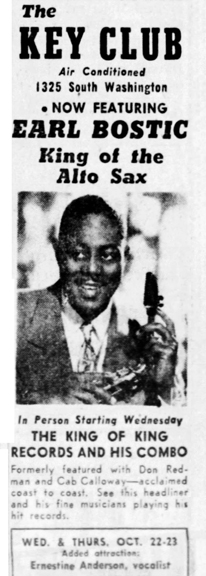
The Treniers were indeed Fabulous, and they came to the Key Club on October 31, until November 9, 1958. What an act! In 1956 alone they appeared in Alan Freed’s “Don’t Knock the Rock” and the priceless “The Girl Can’t Help It” – two of the most classic Rock ‘n’ Roll films of all time! In the 1940s they were already playing “Rockin’ Is Our Business,” one of the quintessential proto-rock songs of all time. Here they are on the Martin and Lewis show doing that fabulous song!
Will Jones called them sensational, and wrote that they were blowing the roof off the Key Club with their frenzied and feverish antics. (November 7, 1958)
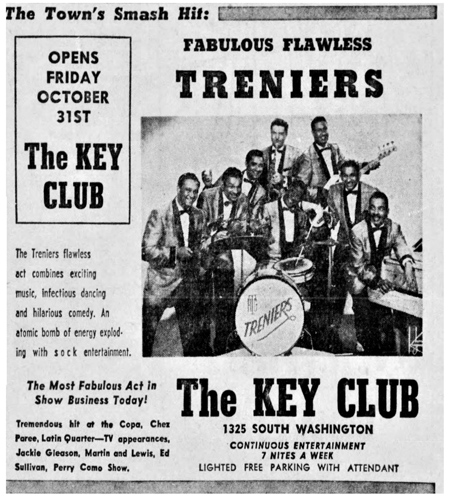
On November 13, 1958, Will Jones reported that there was more remodeling going on at the continually-expanding Key Club to accommodate the larger crowds that the big name act policy had been bringing in. The place was to have the capacity for 400.
Billy Williams and his Quartet performed at the Club from November 17 to 30, 1958. Billy’s signature song was his version of Fats Waller’s “I’m Gonna Sit Right Down And Write Myself A Letter” in 1957. The record sold over one million copies. His trademark was to shout “Oh, Yeah” at the end of lyrics.
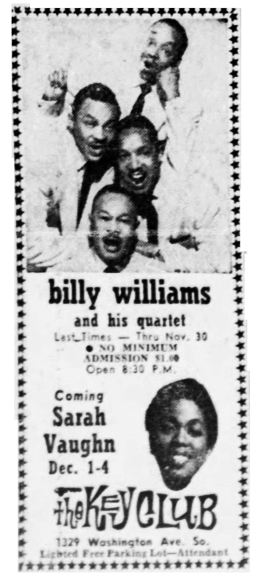
THE KEATON MURDER
On November 20, 1958, Morris N. Keaton and an unidentified man had an argument over a mechanical bowling game at South of the Border. William L. Ferrell intervened, and a scuffle broke out, in which Ferrell struck Keaton, breaking his glasses. Both Keaton and Ferrell were bounced from South of the Border.
Keaton went home, but then returned to South of the Border, where he stayed until it closed. Then they went to the Old Southern Barbeque, where he again encountered Ferrell. They argued, and Keaton followed Ferrell into the men’ room. Keaton asked Ferrell why he had broken his glasses, and they fought, knocking out part of the bathroom wall. Then Keaton took out a .38 and shot Ferrell twice. Keaton left, went home, emptied his gun, and asked a fellow roomer to drive him to the police station so he could give himself up.
Sarah Vaughan and her Trio had a four day stay from December 1 to 4, 1958. Also on the bill were Pete Digges and his Vibes, and the Horace Henderson Combo. And again Will Jones complained about not being able to hear because of customer “yakking.”

Dinah Washington appeared for one week from December 6 to 11, 1958. (See ad above) She was 10 minutes late one night because she found out that some friends from Chicago had come to see her, and she wanted to wear a specific gown, which was back at the hotel. Then she improvised some lyrics to fit the occasion. She had also read Jones’ complaints about not being able to hear, and “belted ever note firmly against the farthest wall of the place.” After the session, she came up to Jones and asked demurely, “Could you hear me, honey?” (Tribune, December 9, 1958)
The Slappy White Revue came to make the audience laugh from December 14 to 21, 1958. Also on the bill were vocalist Jean Turner, and dancing star Tito Cavalaro. Horace Henderson’s Sextet was on hand to provide the music.

Ben Webster performed at the Key Club from December 22 to 31, 1958. Webster was a tenor sax player with Duke Ellington and Cab Calloway. Also appearing was singer Jean Turner and the Horace Henderson Combo.

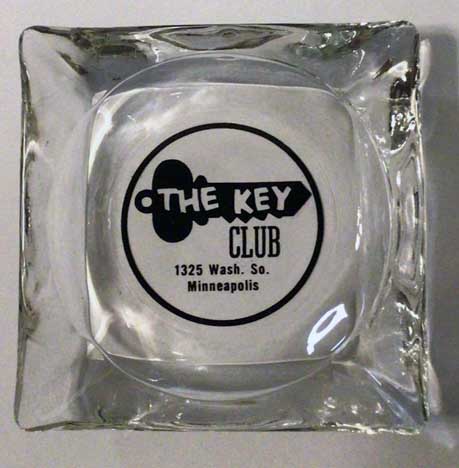
1959
Sister Rosetta Tharpe opened the 1959 season. “Sister” was more or less a nickname, she said – she wasn’t Catholic. When she was performing with Cab Calloway she was called “Little Sister.” In 1959 she was 38 years old. Her signature songs were “Don’t Take Everybody to be Your Friend” and “Strange Things Happening Every Day.” (Minneapolis Star, January 5, 1959) On the bill with her were blues singer Jean Turner and exotic dancer Charmaine. The Horace Henderson Combo provided music for dancing.

Drummer Cozy Cole and Quintet, featuring Barney Bigard, performed from January 14 to 23, 1959. On the same bill was Big Maybelle. Cole had p;ayed with Cab Calloway, Raymond Scott, Artie Shaw, Benny Goodman, and Louis Armstrong. Cole was mostly known for “Topsy Parts I and II.”
Big Maybelle was apparently held over, at the Club on January 26, 1959.
GOING SOMEWHERE?
On February 9, 1959, for some reason Sabes honked at two Golden Valley police officers who were traveling east on Highway 55 in Golden Valley, while Sabes was driving west. The cops turned around and went after Sabes, who took off. A high-speed chase ensued, with speeds up to 80 mph. They traveled for 40 miles, into north Minneapolis, along Glenwood Ave to Highway 200, to Highway 55 nearly to Hamel, and west again on Highway 55. The police lost Sabes a couple of times, but newly-fallen snow helped them pick up the trail. He was finally stopped by a Hennepin County Sheriff’s roadblock on Highway 55 a few miles east of Rockford at about 3:55 am. Sabes was charged with reckless driving and fined $100. His motivation for the escapade was never revealed. (Minneapolis Star, February 9 and 11, 1959) A subsequent article characterized the incident as drunken driving (Minneapolis Star, April 21, 1961)
Also in February 1959, the Key Club was sued for serving liquor to an intoxicated man who then stole a cab and hit a pedestrian. In December 1960 a settlement of $3,500 was made against Sabes.
Roy Milton, February 1959
Jimmy Witherspoon, February 1959
Sarah Vaughan, March 16-22, 1959
T-Bone Walker, “The Daddy of the Blues,” appeared with his son at the Key Club from March 23 to 29, 1959. Also on the bill were the Four Dukes, performing songs, dancing, and comedy. The Fouchee Dancers were also on hand.

Singer Abbey Lincoln performed for a week, March 30 to April 5, 1959. The Four Dukes and the Fouchee calypso Dancers were also on the bill.
Ray Charles and the Raelettes, April 6-12, 1959
Ernestine Anderson, April 13-19, 1959
Joe Medlin, April 20-23, 1959
Della Reese, April 24-May 3, 1959
Lambert, Hendricks, and Ross, May 4-10, 1959
Chris Connor and her Trio, May 11-16, 1959
Miles Davis and his Quintet appeared at the Key Club on May 18 to 24, 1959. With him were Julian “Cannonball” Adderly on alto sax; John Coltrane on tenor sax; Paul Chambers, bass; Wynton Kelly, piano,; and Jimmy Cobb, drums. Much was made of Davis’ disdain for the press and his audience, but he had a cult following. (Minneapolis Tribune, May 20 and 21, 1959)
Tommy Edwards and Donna Hightower shared the billing from May 25 to 31, 1959. Edwards was best known for his hit, “It’s All in the Game.” The Duke Groner Band provided the music for the two performers.
Eddie “Lockjaw” Davis, solo tenor sax, with singer Donna Hightower, June 1-7, 1959
Martha Davis and Spouse, June 8-14, 1959
Ruth Brown and the Paul Williams Band, June 15-21, 1959
Clyde McPhatter, June 22-28, 1959. McPhatter sang with the Dominoes, the Drifters, and had a solo career. He died in 1970 at the age of 39.
Louis Jordan and His Tympany Five, June 29-July 11, 1959
From July 13 to 17, 1959, the bill featured Lonnie Sattin, a popular singer of the time and cousin to songstress Dakota Staton. The Fouchee Dancers came second on the bill, and third was the controversial Stepin Fetchit (Lincoln Perry). Step was known as the “Laziest Man in the World” for his persona in movies he made, peaking in the 1930s. Although criticized for the image he portrayed, he was also the first black millionaire. A complicated person.
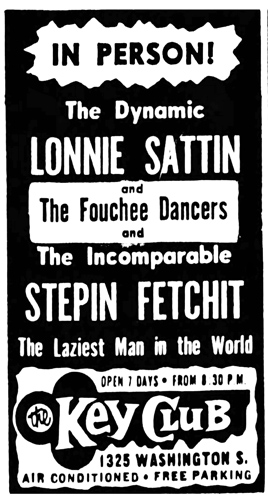
Brook Benton, July 27-August 2, 1959
Bobby Freeman appeared at the Club from August 10 to 16, 1959. Freeman was known for his hit, “The Swim.” Also on the bill were the the dance team the Three Leggers (back for a second stint at the Club, the McCoy Sisters, and the Pete Digges Band.
Ink Spots, August 17-30, 1959
Sammy Turner, with Doris Hines, August 31-September 6, 1959
Steve Gibson and the Red Caps – as seen on Ed Sullivan, Jackie Gleason, and Arthur Godfrey, September 7 to 21, 1959
Anita O’Day was scheduled for September 20 to 27, 1959, but she got sick in New York and missed her opening night. She showed up for the rest of the run, heading up an all-star revue called the Flamingo show. Charles Hanna of the Minneapolis Tribune reported that it was her first performance in Minneapolis; she had appeared in St. Paul in 1948 and 1949.
Will Jones wrote that she looked “bright and little-girlish in a demure blue dress with white lace collar and little white gloves.” He also reported that:
She wouldn’t trust her pipes to the backing of the rock ‘n’ roll house band, so he’s singing up her cool little storms with the backing of a borrowed band (the house group from Herb’s who aren’t working while The Three Sounds are at that place.)
Besides Miss O’Day, the Key Club this week imported a new packaged show that includes a 63-year-old stripper billed only as Caledonia, and a line of 4-girls-4. During my visit there, the girls performed a sadistic little number in which they dance with torches and apply them to the epidermis of a male dancer who appears as an unfortunate citizen who gets washed up on the amazons’ beach. How the guy keeps from getting cooked is his secret. (Tribune, September 24, 1959)
Nellie Lutcher, September 28 to October 11, 1959
Singing star Roy Hamilton appeared on October 12 to 18, 1959. Also on the bill were the Flamingo Dancers, vocalist Doris Hines, and the Larry Wrice Combo.

Hammond organ stylist and pianist Bill Doggett appeared on October 19-25, 1959. His big hit was “Honky Tonk, Parts I and II.” Local singer Doris Hines joined him, as well as comic Dave Turner and singer Val Martinez.
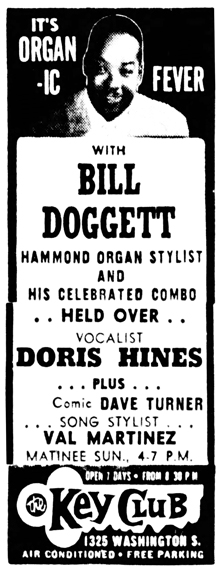
Gloria Smyth, November 2-15, 1959
The Key Club continued with its major musical acts, although performer Christine Jorgensen was known more for her Danish sex change operation than her stage show. She was paid $2,000 for her appearance, from December 25, 1959 to January 3, 1960. Near the end of her act, she sang “I Enjoy Being a Girl.”
1960
Illinois Jacquet, January 4, 1960
Etta James graced the stage of the Key Club in February, 1960. Miss James was famous for numerous R&B hits, including “The Wallflower” (a/k/a “Dance With me Henry”) and the quintessential version of the 1941 song “At Last.” Also on the bill were the Dancing McCoy Sisters, a contortionist called the Great Bender, and Pete Gentry’s Band.
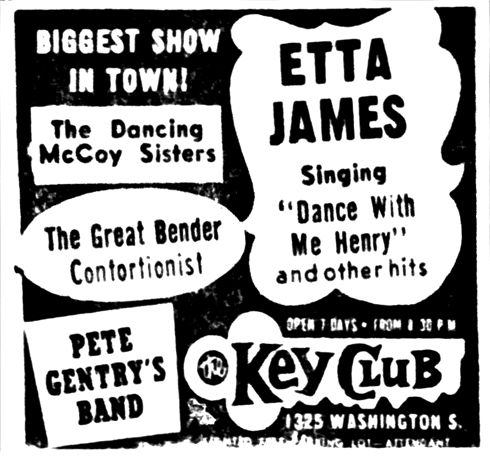
Billy Eckstine appeared at the Key Club from February 26 until March 6, 1960. Sabes, along with various other businessmen offered the NAACP one half of the proceeds from Eckstine’s 10-day run to be used in hosting the group’s national convention in the Twin Cities that June. (Minneapolis Star, February 23, 1960)
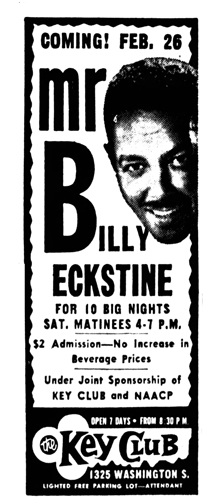
The Flamingos – March 28, 1960
Step Brothers, April 15, 1960
Dakota Staton, April 22, 1960
Cle’a Bradford was the a jazz singer from Chicago, appearing from May 2 to 8, 1960. Will Jones wrote that he often enjoyed lesser-known names better, as a couple of the “well-paid ladies” who had appeared at the Club recently appeared to be “audience haters.” Miss Bradford had an apparent liking for her audiences.
Jones also wrote that audiences were likely to bbe offered a nibble of free Vescio’s pizza, which had opened as a new room in the club. At slow times, cook John Evangelist “whomps up a big pizza and sends it over into the show room to be passed around” to lure new customers. Jones recommended the bracioli (stuffed beef), a specialty at the Dinkytown Vescio’s. (Tribune, May 6, 1960)
Chris Connor and Her Trio, May 13, 1960
Frankie Lymon, still only 18 years old, appeared at the Key Club on May 25, 1960. The bill also included singers Elizabeth Lands and Tommy Brown, and dance and mimic team Turner & Johnson. Horace Henderson was the house bandleader.
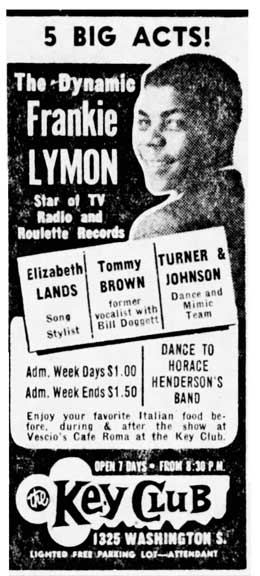
Loray White (Sammy Davis, Jr.’s ex-wife), June 6, 1960
Cab Calloway his own self appeared on June 20, 1960. Horace Henderson led the house band.
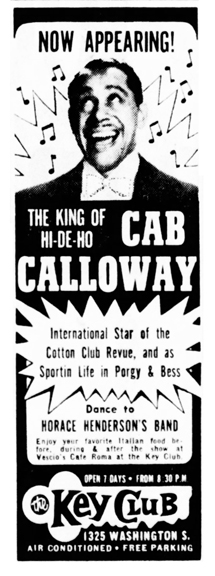
Redd Foxx, “The Funniest Man in the World,” appeared at the Key Club on July 7, 1960. Also featured were Lorez Alexandria, and exotic dancer Ann Inga.

The Hortense Allen Revue led the bill from September 12, 1960, to the end of October. Also on the bill was “Mr. Emotion” Bunny Sigler, who could imitate Ray Charles. Song stylist Clea Bradford entertained, and Count Belcher provided dance music.
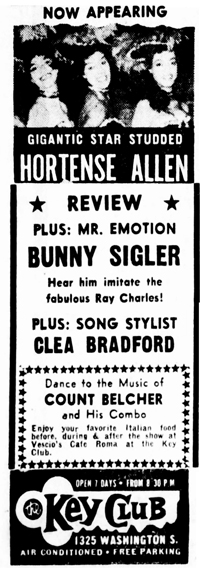
The Treniers, October 1960
Perri Lee (Blackwell) was a jazz organist and pianist, who, as the ad says, sang a duet with Doris Day in a nightclub scene in the movie “Pillow Talk.” Also on the bill was vocalist Vi Jefferson. Doughty’s Pit Smoked Bar-B-Que was on the menu.

1961
Roy Milton featuring Mickey Champion, blues and ballad singer, January 19, 1961
Ink Spots Revue, featuring Bill Josephs and Daisy Banke, March 15, 1961
BIG NAMES OUT
Apparently the Big Name Policy took a vacation in the spring of 1961. The ad below from April 6 features the Gene (Bow Legs) Miller Band, Comedian and M.C. Johnny Q. Nut, and exotic dancers Hana Chan and Alicia McNeil. Doughty’s Pit Smoked Bar-B-Que was on the menu.
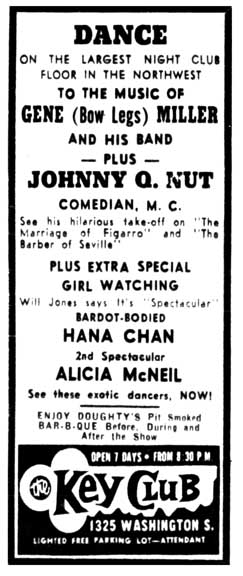
THE HOCKETT SHOOTING
On April 14, 1961, Sabes shot two patrons, one on purpose and one by accident. Both survived. Richard Hockett, age 30, wanted to take his drink out into the street at closing time, and when told that this was illegal, he smashed his glass on the floor. He was tossed out by the cook and the floorman, and five minutes later he came back with a gun that he pointed at the floorman and Sabes.
Two detectives happened to be in the Club on a routine check, but before they could react, Sabes shot Hockett, who ended up with a bullet lodged at the base of his skull. Also wounded was bystander Cecil W. Carter, age 35, who was struck by a stray bullet and suffered a skull fracture. Hockett denied having a gun, but a pistol was found on a coat room shelf. It turned out that Hockett’s gun was rigged so that it could shoot all seven bullets at once, potentially firing “like a machine gun.”
Sabes was not arrested but the Hennepin County Attorney insisted that the Mayor or the Chief of Police sign a complaint charging Sabes for first degree assault. When no member of the police force would sign the complaint, the County Attorney dropped the charge. At the time the police called the place “a known hangout for criminals, and detectives regularly check the place.” (Minneapolis Star, April 14, 1961)
Although the police and Hockett refused to press charges, wounded bystander Carter filed first degree assault charges against Sabes on April 25, 1961. Bail was set at $3,000 but Sabes was released on his own recognizance. A hearing was held before a judge, and the charge was thrown out on May 8, 1961. The deciding factor was Hockett’s gun, rigged to fire seven bullets at a time. The judge said that although Sabes’ action was drastic, it turned out that “it surely prevented seven imminent potential murders.” (Minneapolis Star, May 8, 1961)
The Hortense Allen Review provided entertainment in April 1961, along with vocalist Mildred Anderson. Gene (Bow Legs) Miller continued as house bandleader.

Will Jones reported on May 25, 1961, that given the bad publicity the club was getting, Sabes was thinking of changing the format to Country. Road Buddies was taking over a room in the Key Club, and trying out a C&W policy, starting with Chuck Carson’s band on June 1, 1961.
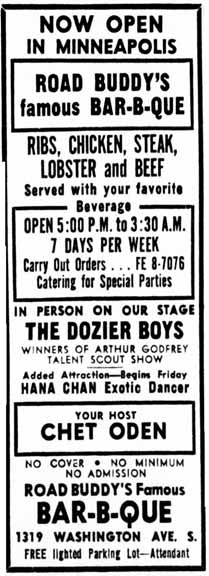
The fabulous Dozier Boys came to the Key Club on September 1, 1961. Augmenting the bill was the lovely Doris Hines. Chet Oden’s Road Buddy’s Bar-B-Q was available.

HERB KLEIN
The ad below announces that Herb Klein was now the host of the Key Club. Not sure if that meant he was the permanent MC or the General Manager. Klein was a brother-in-law of Sabes, and had opened his own club, Herb’s, at 324 Marquette Ave. in Minneapolis in 1946. That building was torn down in 1961 for the Gateway Clearance project, which is when Klein came to the Key Club. Klein opened a second iteration of Herb’s at 654 Second Ave. No. at Glenwood Ave. in late 1963.
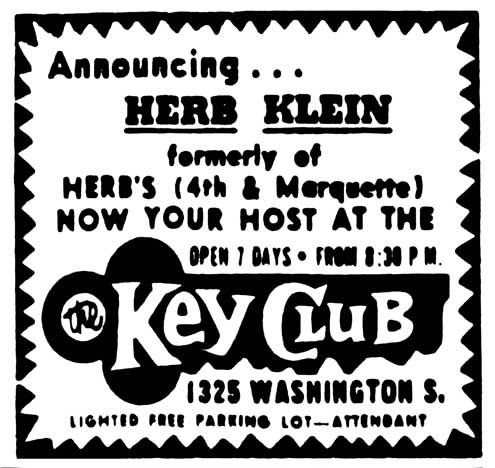
The ad below from October 1961 features singer Laura Johnson, but the Dozier Boys were the big act on the bill, either back or held over from September. Filling the card were MC, comedian, and dancer Cadillac Willie and exotic dancer Kahlua. Chet Oden’s Road Buddy’s Bar-B-Q was available. What a night!
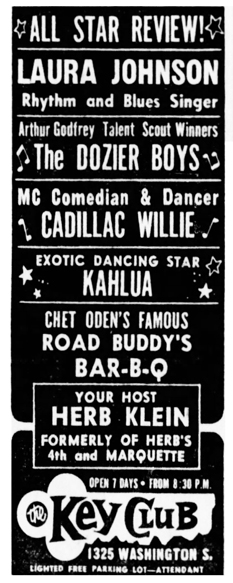
Earl Bostic made a return engagement from November 10 to 19, 1961. The club was served by Chet Oden’s Road Buddy’s Bar-B-Q.
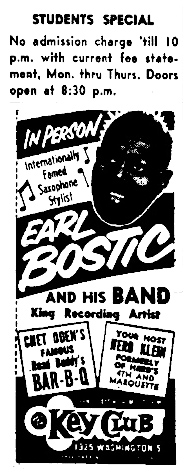
The Key Club instituted a scantily-clad waitress policy with a twist – all of its waitresses were black. Juanita Green was the first to don the new costume and model it in Will Jones’s column. It was not racy by our standards at all.
The International Jazzmen entertained for four nights, on November 20 to 23, 1961. The band featured Eddie (Exodus) Harris and Jay Peters on battling saxes
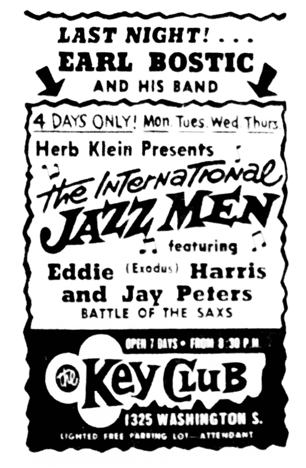
The Flamingos were in the Club from November 24 to December 3, 1961.
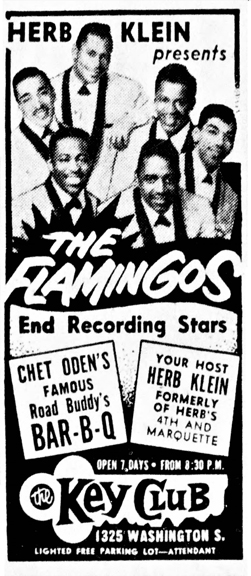
BILL DOGGETT AND THE TWIST
Bill Doggett returned for an extended engagement, from December 4 to 17, 1961. This may have been the first reference to the Twist, which really took off in 1962.
The Twist was hot and in December 1961 the Key Club offered Twist lessons to its patrons. Will Jones reported on December 18 that:
It was a wild, wild night at the Key Club. Bill Doggett’s twist music proved so infectious, one woman patron jumped onstage and began to strip which isn’t exactly the idea. The management hustled her off.
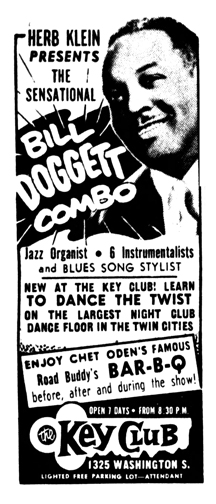
The Hortense Allen Dancers came to teach the Key Clubbers to do the “controversial” twist, to the music of the Bill Pinkard Trio and blues singer Harold Connors, formerly with B.B. King. This lineup probably began on December 18, and was described as an unlimited engagement by the Minneapolis Spokesman. (December 22, 1961)
1962
On January 30, 1962, Will Jones reported that the socialites and suburbanites had discovered the Key Club and invaded the place on weekend nights to be taught the dance by “those wild, wild” Hortense Allen Dancers.
Variations of this ad appeared throughout 1962. This particular one below appeared on March 24, 1962.
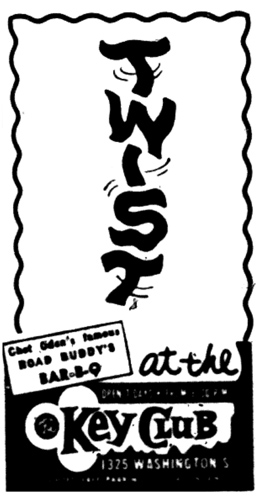
In mid-1962 the Minneapolis Star and Tribune went on strike, and the slack was taken up by a Minneapolis businessman who put together the Minneapolis Daily Herald. On June 22, 1962, the Herald published an ad for the Key Club, promising to teach all comers to do the Twist. The show starred Comedian-MC Sandman Howard and the Beautiful Key Club Twisters, and Chet Oden’s famous Road Buddy’s Bar-B-Q was available.
On July 30, 1962, an ad in the Herald showed that the new Comedian-MC was Leroy Watts, and music was provided by Count Belcher and His Band. A picture was provided of two of the beautiful Key Club Twisters, but the microfilm doesn’t translate well. “Everybody Twists at the Key Club.”
On August 1, 1962, Vic Burton’s Night Beat column in the Herald described the Key Club’s Twist show, emceed by Leroy Watts. There were three women who demonstrated the dance: Helena DeCarlo, Penny Wallace, and Watts’s daughter, Cyoreta. Helena does an added fire dance. They also got the audience up on the floor; Watts said that they teach the twist to more than 600 people each week, and one night they had 200 beginning twisters on the dance floor at one time. Some speculated that it was just a fad, but others gave it at least three years. To mix it up, there were other new dances, such as the Popeye, the South Street, the Loca-Motion, the Stair, the Watusie, and “several other jazzed-up versions.” “But whatever the twist is, if Jackie Kennedy does it – it can’t be all bad.”
In September 1962, Herald reporter Bob White wrote about the act Pete and Repeat, who were starring in the stage show, and who had appeared at the Club before in August 1958.
These two talented fellows must wear out a set of taps each night with their exciting dance routines. They must wear themselves out with their sensational splits, spinarounds, flipovers, and knee bends. These boys are headed for the top.
Performing with Pete and Repeat was Leroy Watson, M.C. and dancer, who was twice their age but executed some of the same difficult steps and stunts as the younger dancers. Watts injected showmanship into acts of ordinary talent. White noted that Mrs Watson made all the costumes for the act, which included a “technicolor costume dance” called “Night in Tunisia” featuring Penny and Cyoreta. He described the act as “every bit as fascinating as an act at the Lido in Paris or the Copa in New York.” Count Belcher’s band provided music for the show and for dancing – mostly twist music. (Minneapolis Daily Herald, September 12, 1962)
THE END, PART I
On September 26, 1962, the Minneapolis City Council License Committee ordered police and health department reports on the South of the Border Bar, the Key Club, and the Old Southern Barbeque, which had been called “known hangouts for narcotic addicts and prostitutes.” The accusations were made at a Federal District Court trial by a former head of the police morals squad. The Committee also asked the City Health Department to report on venereal disease contacts in the three locations. (Tribune, September 27, 1962)
A series of hearing were held, at which police officers testified that 89 arrests were made since 1958 because of activities of prostitutes in the South of the Border and the Key Club.
Sabes offered to close the bar if he could keep the Key Club open. Then he proposed moving the bar to a better neighborhood and turning it into a supper club. Then he tearfully asked the City to allow him to sell the bar and get his investment out of it. (Citation unclear – perhaps Minneapolis Spokesman)
On November 20, 1962, the requested report of prostitute contacts at the South of the Border Bar were read into the record, and the Key Club did not look so good. (Minneapolis Star, November 20, 1962)
After these hearings, the City Council revoked his food, liquor, and entertainment licenses on November 23, 1962. (Minneapolis Tribune, March 23, 1963)
CECIL E. NEWMAN
Sabes found support in Cecil E. Newman, editor of the Minneapolis Spokesman, who pointed out, in a letter to the editor to the Minneapolis Tribune, that the Key Club was the first night club in Minneapolis to break the color line against black artists and provided the best in contemporary jazz music and entertainment. It was one of only a few establishments that hired black musicians, bartenders, waitresses, floormen, and maintenance people. He pointed out that it had 17 permanent black heads of families with 23 dependents. Newman called it “The first night club in Minneapolis to break the color bar against Negro artists in night clubs.” Plus it was one of the few places black patrons could go and feel welcome. Newman had been to almost ever club in town, but often had been the only black person there.
He felt that the Key Club and South of the Border were being held responsible for events that happened blocks away from the clubs, and that the “social misfits” of narcotics addicts and prostitutes hang out in a large number of places in Minneapolis. (Minneapolis Tribune, December 12, 1962)
Sabes filed an appeal to the Minnesota State Supreme Court, which allowed him to stay open until that court rendered a final decision.
1963
The ad below from January 1963 declared the Key Club “Now Open!” The club was only open three nights a week. This time the music featured the Bossa Nova instead of the Twist.
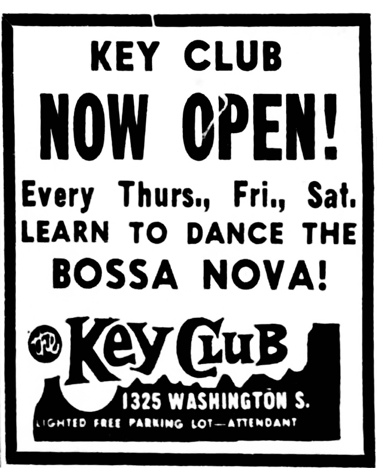
From February 7 to 14, 1963, the Bardettes provided the music, featuring vocalist Charles Singleton. Also entertaining were the Harlemet Dancers.
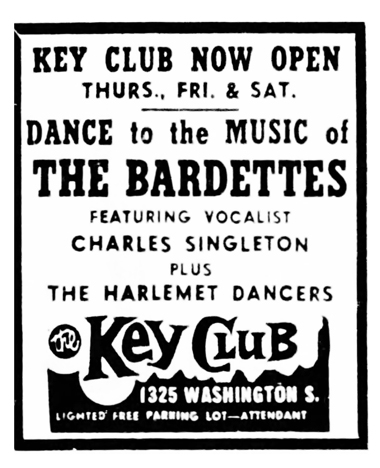
Dakota Staton turned out to be the last act of the original Key Club, performing from March 11 to 17, 1963. In his column of March 13, 1963, Will Jones commented that the club’s “showmanly gambit of booking jazz names in the face of its legal troubles is paying off. Dakota Staton has brought some life back to the club, once thought dead.”
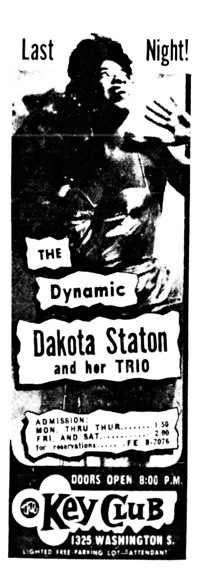
THE END, PART II
On March 22, 1963, the Minnesota Supreme Court upheld the Minneapolis City Council’s revocation of Sabe’s food, liquor, and entertainment licenses in a 6 to 1 decision. The decision said that Sabes was charged only with knowing that prostitutes were frequenting his establishment and that numerous convictions resulted from the acts of prostitutes who solicited on his premises. Further proof was not required to sustain the revocation of his licenses. “No citizen has an inherent or vested right to sell liquor, and municipal authorities have broad discretion to determine the manner in which a license shall be issued, regulated, or revoked.” The decision also said that a bar operator was responsible for conduct on his premises, and that Sabes was violating state law by permitting his club to be used as a hangout for prostitutes.
Sabes told the Court that he had invested fore than $160,000 in the business and that its value was more than $200,000. Club Manager Mel Bellman testified that he and seven other employees would lose their jobs, including four bartenders, one waitress, and one porter – more employees had been let go after the City Council had revoked the licenses.
Sabes voluntarily closed the clubs on March 22; the licenses would have expired on March 31, 1963. (Minneapolis Tribune, March 23, 1963)
Now a pause for some background on the successor to the Key Club:
FRANK SEIFERT AND THE INN-TUITION CLUB
1429 Washington Ave. So.
The building that was the home of the original Inn-Tuition Club had been the home to the Seventh Corner Bar since the late 1938s.
In May 1961, the Seventh Corner Bar had been involved in the Purity Soap scandal, in which Minneapolis Alderman Romeo Riley, who was on the committee that awarded liquor licenses, sold soap to several bars. Somehow Kid Cann was involved. At the least it was a conflict of interest.
The only other mention of the Seventh Corner Bar was the painting below, painted by Leatrice Hoover of Roosevelt High School, who won the Ingersoll State Award in the annual Scholastic magazine arts competition. The picture went on exhibit at Carnagie Institute in Pittsburgh.
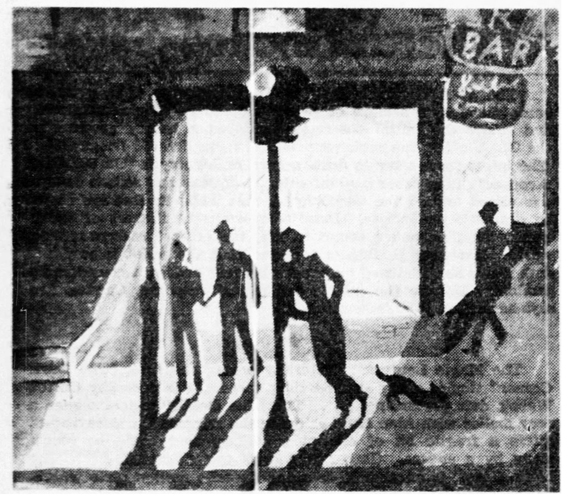
The Inn-Tuition
On October 14, 1961, Frank Seifert opened the Inn-Tuition Club. Seifert was an announcer at WTCN-TV.
To prepare the long narrow space for his new club, Seifert built a wood frame balcony on the second floor, and took out the front glass window and closed it up. His first act was a fellow WTCN employee, Don Marlowe, who did comedy. He hired jazz trios to perform between sets. Entertainers performed on the balcony.
Besides being the Year of the Twist, 1962 was also the Year of the key club. A key club (lower case) was open to those who paid a membership and met certain criteria. At the Inn-Tuition, memberships were $10 (presumably per year?), drinks were cheap, and members had to be
- unmarried
- employed
- 21 or over
Seifert advertised that he would open as a key club in March 1962, but demand was so high for memberships (especially women) that he shut down on April 7 and reopened under the new structure on April 23, 1962.
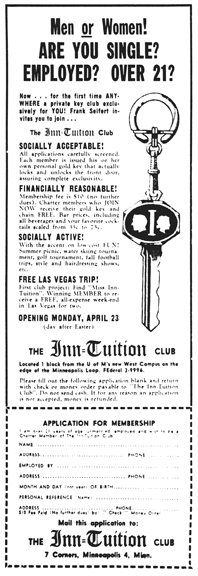
Vic Burton, writing for the Minneapolis Daily Herald, seemed to have a good point when he wrote that that the best way to make money in the Minneapolis bar business is to keep most people out. He noted that the Inn-Tuition now had rules that ruled out about 99 percent of the population. He wondered how one went about proving he was single – it was one thing to prove you were married, but the opposite? He did like that the singers at the piano bar sang softly. An open house was scheduled for May 5, 1962. (May 3, 1962)
Vic Burton’s column of August 6, 1962, revealed that Frank Seifert realized that the Key Club of old, with big name entertainment, was on its way out, because people could see the stars on television for free and didn’t have to go to a nightclub anymore. So he had to offer service and exclusiveness as a substitute for the big names. (Minneapolis Daily Herald)
MOVING TO THE KEY CLUB
Seifert quit his other job at WTCN in November 1962, and stated his intention to move to a warmer climate due to chronic bronchitis. But when the (upper case) Key Club closed on March 22, 1963, he set his sights on that, looking to expand even further. On March 29, 1963, he applied to move his liquor license from 1429 Washington Ave. So. to 1327-29 Washington Ave. So.
After delaying action seven times, the City Council approved his application on July 26, 1963. Seifert rented the Key Club building from Sabes for $800/month. Members of Seifer’s old Inn-Tuition Club would have exclusive use of South of the Border, and the former Key Club would become known as Frank Seifert’s.
FRANK SEIFERT’S
Frank Seifert’s opened on August 9, 1963. He had two house bands: the Key Noters played Bossa Nova, Fox Trot, Waltz, Mambo, and Cha Cha, while Augie Garcia covered Rhythm & Blues, Twist, Surfing Rhythms, and Jazz. The large dance room was open to the public for $1 admission charge.
When revealing his plans to Will Jones for the club, Seifert said he wanted no intermissions, and an atmosphere “like a small town on a Saturday night. Every night.” Dudley Riggs would operate the food concession, which was to include steak and eggs, fish and chips, small steaks, marinated bourbonburgers, and a salad cart. Riggs would not offer any of the fancy coffees or pastries featured at his separate Cafe Espresso. (Tribune, July 29, 1963)
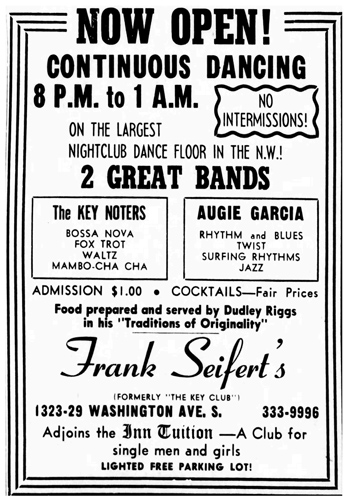
Ads like the one above ran through August 1963 but stopped.
Will Jones complained that “the combination of Augie Garcia’s band and the old Key Club sound system adds up to so many decibels that life in the dance-hall part of Frank Seifert’s is unbearable… I’ll take some engineering.” But he found the Inn-Tuition bar was quiet and pleasant, and was more than pleased with the food service. (Minneapolis Tribune, August 19, 1963)
NAME ACTS
On October 1, 1963, Will Jones noted in his column in the Tribune that Frank Seifert’s had reverted to a show room with name acts. Ronnie Newman’s Keynoters stayed on as the house band. The first big name was Lisa Carroll, who began her run on October 5, 1963, according to the ad below. (Jones said Friday night, which would have been October 4.) According to Jones and the ad, Carroll appeared on the Steve Allen Show on October 2, 1963. On the same bill with Carroll was a duo called the Kay-Eds.
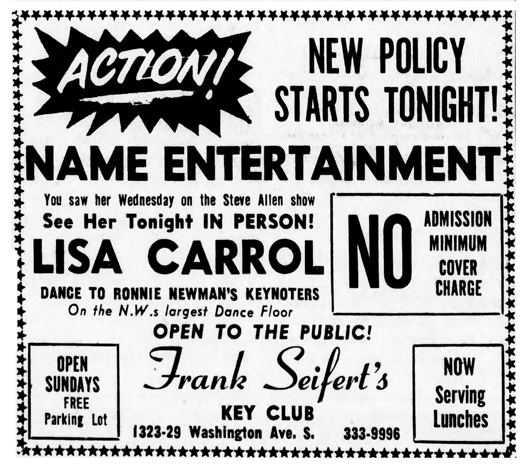
On Friday, October 11, 1963, singer Molly Bee was scheduled to appear for a week, according to Will Jones.
1964
BACK TO THE KEY CLUB
This name change did not last long. By the first anniversary, the club was still being run by Seifert, but it was back to being called the Key Club. With few exceptions, the entertainment was provided by Mojo Buford and His Chi 4. In 1964 they were still playing Rhythm & Blues.
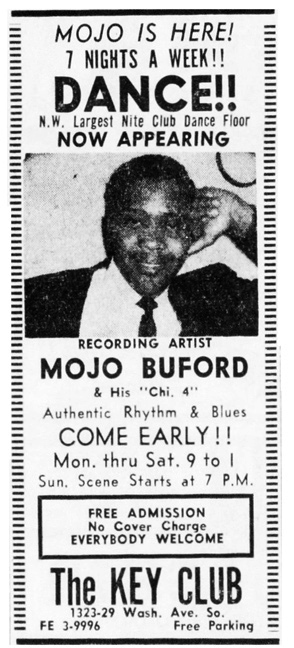
A telling column from our friend Will Jones on July 1, 1964:
After a long dry spell, things are swinging once more at the Key Club. In addition to the Wednesday dance contests, Seifert is starting other special nights this week. Thursday it’ll be talent night, and he has worked out an arrangement to turn over the $1 admission charges to the NAACP to help pay fines for civil rights workers in Mississippi and Florida.
A bikini beach party will be the Saturday attraction, with everybody invited to turn up in bikinis and compete. Seifert says he’s keeping his fingers crossed on the matter of topless bathing suits, but he won’t say what he’s wishing when he crosses his fingers. Nest Monday he starts a celebrity night.
“Mr. Personality,” Bob Ross, formerly with the Ink Spots, appeared with Mojo for a limited engagement at the end of October 1964.
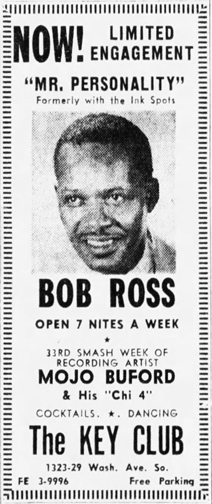
1965
Mojo Buford was a blues artist, but if the people wanted “discotheque dances,” you go with the flow. And 1965 was definitely the year of the Go-Go! Contests for such dances were held on Mondays, Tuesdays, and Wednesdays. On Thursdays there were Talent Contests, promising Beautiful Prizes. 1965 was the second year that Mojo Buford and His Chi 4 did their duties as the house band.
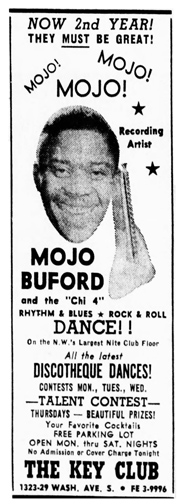

From July 19 to 25, 1965, Chicago blues guitarist Earl Hooker paid a trip to the Key Club. Hooker was a cousin of the better-known John Lee Hooker. Given the tenor of the day, his band was called the Rockin’ Soul Twisters, featuring Lee Shot Williams and A. C. Reed. Hooker and Mojo Buford carried out a Battle of the Bands for Hooker’s one week stay.
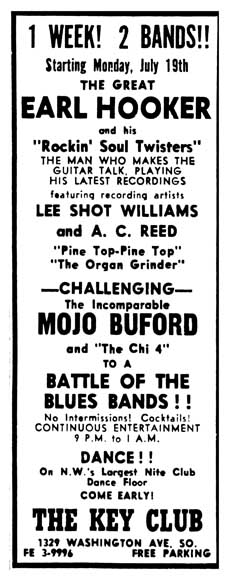
Legendary bluesman Muddy Waters came to the Club on July 26, 1965, and was present for the Ike and Tina show on August 2. He and his Band were held over until August 5.
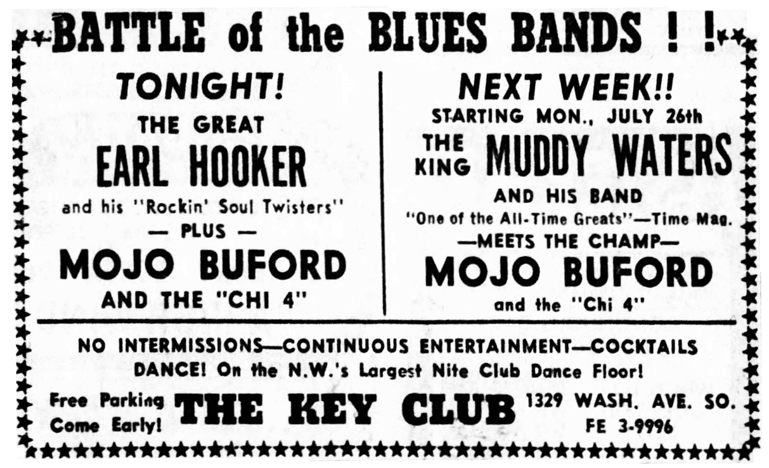
The Key Club went out with a bang, with a show by Ike and Tina Turner on August 2, 1965. On the same bill were Muddy Waters, and Mojo Buford and the Chi 4. The house must have come down!
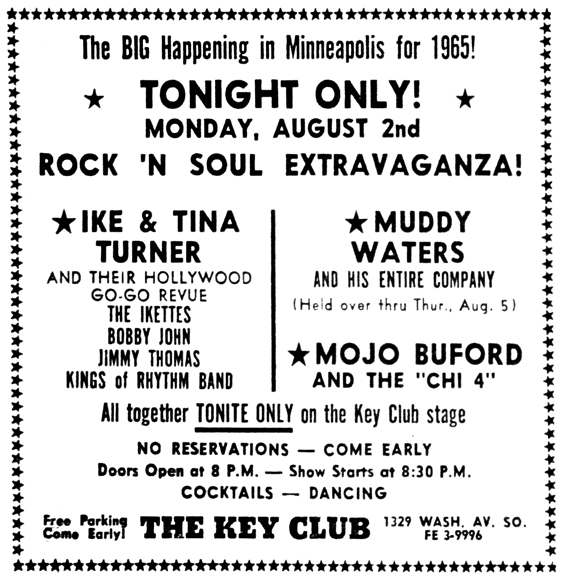
It was a full card opening on August 23, 1965, starting with the Paul Weston Quartet featuring Saundi Taylor, “The Golden Go-Go Girl,” “Direct from ‘Shindig.” Except that there is nobody by those names associated with “Shindig” that can be found on Ye Olde Internet. Hmmm….
The regular house band, Mojo Buford and The Chi 4, was also on hand to make sure there were no intermissions.
And starting tonight was the San Francisco Go-Go Review, “The Most Beautiful Go-Go Girls This Side of Las Vegas.” Will Jones called it the San Francisco Topless Review in his August 22, 1965 column.
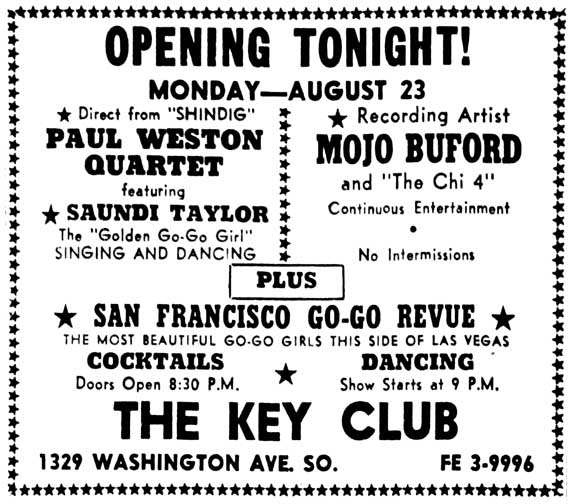
On September 1, 1965, only Saundi Talor (was that a typo?) was in the ad.
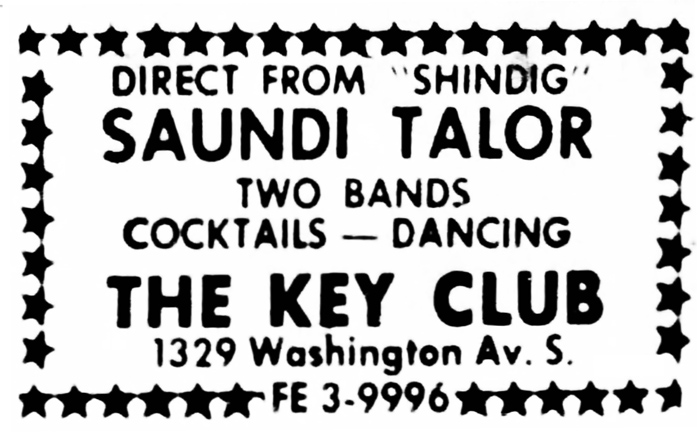
And finally, Mojo closes out the Key Club with the “Biggest Go-Go Show in Town” with Go-Go Girls and dancing. Thanks, Mojo.
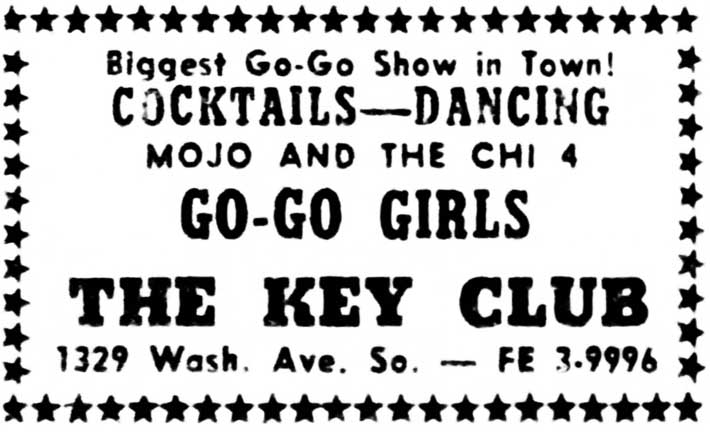
The building was demolished in 1966 and appears to be in the middle of 35W.


